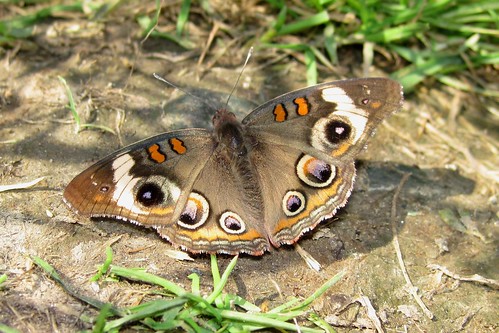
The Common Buckeye is a striking butterfly with bold eye spots that can be flaunted in an attempt to guise as an owl and intimidate potential predators. Just looking at the picture of this gorgeous insect, it isn't hard to believe that it would be exciting to see one at the North Branch Nature Center, but what makes this sighting special is that the Common Buckeye is amongst the rarest butterflies in Vermont.
The mostly tropical genus of Buckeyes are fairly common in the south, where they can be found year-round in some places. The Common Buckeye regularly wanders north in summers, colonizing new areas as it expands northwards, occasionally even penetrating into southern portions of New England, but is extremely rare as far north as Vermont. Colonization in New England is only temporary as this species cannot survive our harsh winters. In fact, no sightings were known in Vermont before 2004 and in the recently completed Vermont Butterfly Survey, it was one of the ten least frequently encountered butterfly species.
While it came as a surprise to find a Buckeye at the Nature Center, it wasn't totally unexpected. 2011 has been an unprecedented year for "southerners" in Vermont, with butterfly species such as Giant Swallowtails (extremely rare and only seen in southern Vermont), Harvesters, and also plenty of Common Buckeyes being reported from numerous locations around Vermont. In fact, on August 24, Bryan Pfeiffer found two Common Buckeyes near Wrightsville Reservoir, just down the road from NBNC.
As climate change progresses and our planet slowly warms, perhaps sightings like this will become more common. After all, while a warming planet will be detrimental to many species, for others, it will create new opportunities. As the graceful Buckeye suns itself on the trails at NBNC, it is somewhat bittersweet that we enjoy its vivid pattern as it flashes its "owl eyes" towards our gaze. While there are many ugly signs of our rapidly changing climate, some come with bright colors and wings.

Nice post and poignant closing paragraph.
ReplyDelete